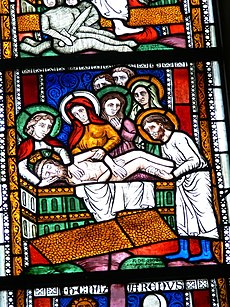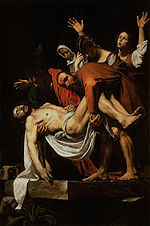Burial of Jesus

The Entombment or Burial of Jesus Christ occurred after his death, when, according to the gospel accounts, he was placed in a new tomb belonging to Joseph of Arimathea.
Biblical account
All four Canonical gospels state that, on the evening of the Crucifixion, Joseph of Arimathea asked Pilate for the body of Jesus, and that, after Pilate granted his request, he wrapped Jesus' body in a linen cloth and laid it in a tomb.[1] John records that Joseph was assisted in the burial process by Nicodemus, who brought a mixture of myrrh and aloes and included these spices in the burial cloth as per Jewish customs. Matthew 27:66 mentions that they "made the tomb secure by putting a seal on the stone and posting the guard."
Theological significance
Paul includes the burial in his statement of the gospel in verses 3 and 4 of 1 Corinthians 15: "For I delivered unto you first of all that which I also received, how that Christ died for our sins according to the scriptures; And that he was buried, and that he rose again the third day according to the scriptures" (KJV). This appears to be an early pre-Pauline credal statement.[2]
The burial of Christ is specifically mentioned in the Apostles' Creed, where it says that Jesus was "crucified, dead, and buried." The Heidelberg Catechism asks "Why was he buried?" and gives the answer "His burial testified that He had really died."[3]

The Catechism of the Catholic Church states that, "It is the mystery of Holy Saturday, when Christ, lying in the tomb, reveals God's great sabbath rest after the fulfillment of man's salvation, which brings peace to the whole universe" and that "Christ's stay in the tomb constitutes the real link between his passible state before Easter and his glorious and risen state today."[4]
Depiction in art
| Part of a series on |
| Death and Resurrection of Jesus |
|---|
 |
|
Portals: |
The Entombment of Christ has been a popular subject in art, being developed in Western Europe in the 10th century. It appears in cycles of the Life of Christ, where it follows the Deposition of Christ or the Lamentation of Christ. Since the Renaissance, it has sometimes been combined or conflated with one of these.[5]
Notable works
Use in hymnody
The African-American spiritual Were you there? has the line "Were you there when they laid Him in the tomb?"[6] while the Christmas carol We Three Kings includes the verse:
Myrrh is mine, its bitter perfume
Breathes a life of gathering gloom;
Sorrowing, sighing, bleeding, dying,
Sealed in the stone cold tomb.
See also
References
- ^ Matthew 15:57–61, Mark 15:42–47, Luke 23:50–56, John 19:38–42
- ^ Hans Conzelmann, 1 Corinthians, translated James W. Leitch (Philadelphia: Fortress, 1969), 251.
- ^ Heidelberg Catechism, Q & A 41.
- ^ Catechism of the Catholic Church, 624-625.
- ^ G Schiller, Iconography of Christian Art, Vol. II,1972 (English trans from German), Lund Humphries, London, p.164 ff, ISBN 853313245
- ^ The Cyber Hymnal: Were You There?
